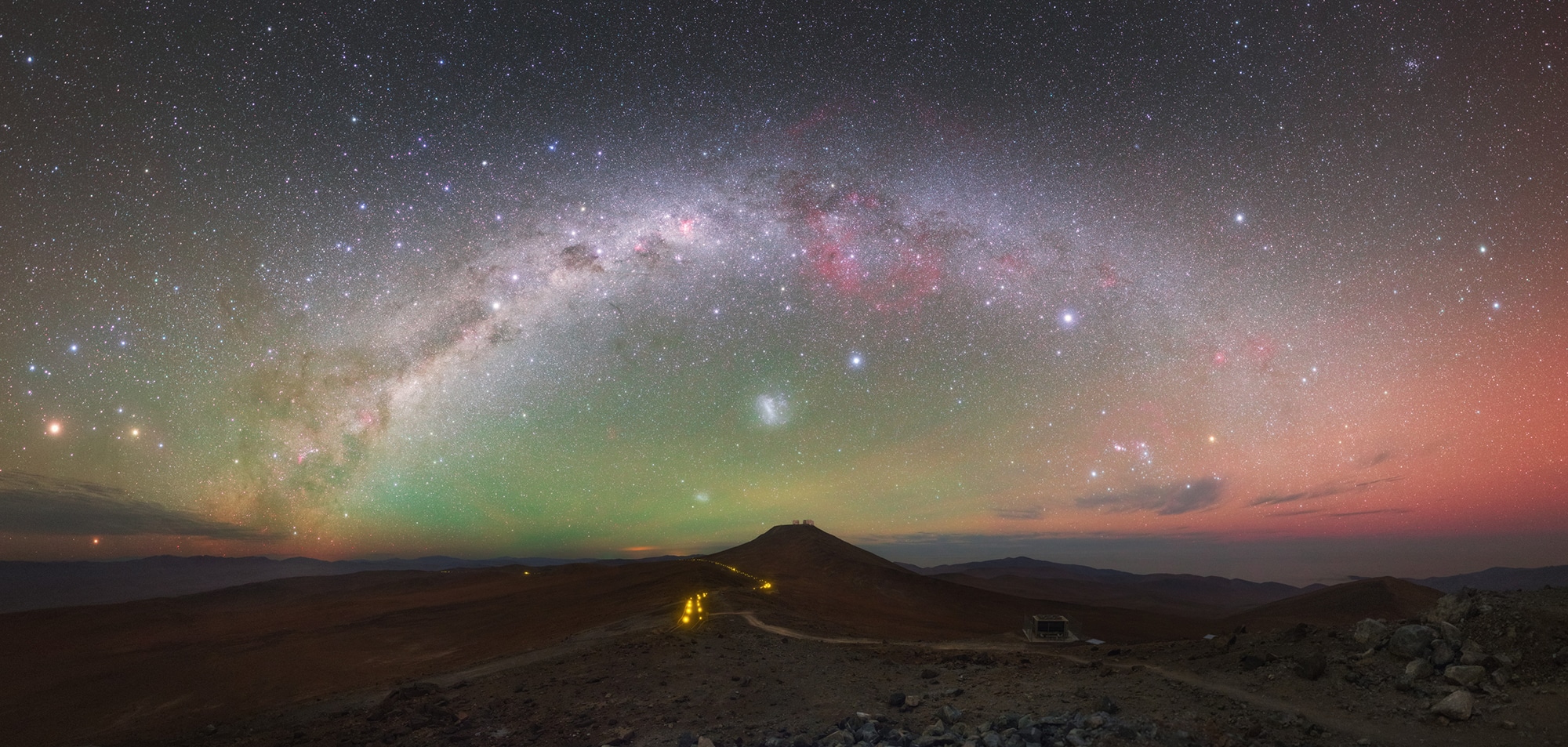About Airglow
- Airglow is the natural “glowing” of the Earth’s atmosphere.
- It happens all the time and across the whole globe.
- The phenomenon is similar to auroras, but where auroras are driven by high-energy particles originating from the solar wind, airglow is energized by ordinary, day-to-day solar radiation.
- Unlike the aurora, airglow does not exhibit structures such as arcs and is emitted from the entire sky at all latitudes at all times.
- There are three types of airglow: dayglow, twilightglow, and nightglow.
- Each is the result of sunlight interacting with the molecules in the atmosphere, but they have their own special way of forming.
- The most common airglow colors are green, red, and blue. However, other colors also occur.
- Dayglow:
- o It forms when sunlight strikes the daytime atmosphere.
- o Some of the sunlight is absorbed by the molecules in the atmosphere, which gives them excess energy. They become excited.
- The molecules then release this energy as light, either at the same or slightly lower frequency (colour) as the light they absorbed. This light is much dimmer than daylight, so we can’t see it by eye.
- Twilight glow:
- It is essentially the same as dayglow, but only the upper atmosphere is sunlit.
- The rest of the atmosphere and the observer on the ground are in darkness.
- So, unlike day glow, twilightglow is actually visible to us on the ground with the naked eye.
- Nightglow:
- The chemistry behind nightglow is different. There is no sunlight shining on the nighttime atmosphere. Instead, a process called “chemiluminescence” is responsible for the glowing atmosphere.
- Sunlight deposits energy into the atmosphere during the day, some of which is transferred to oxygen molecules (e.g. O₂).
- This extra energy causes the oxygen molecules to rip apart into individual oxygen atoms. This happens particularly around 100km in altitude.
- However, atomic oxygen isn’t able to get rid of this excess energy easily, so it acts as a “store” of energy for several hours.
- Eventually, the atomic oxygen does manage to “recombine”, once again forming molecular oxygen. The molecular oxygen then releases energy, again in the form of light.
Q1) What is an aurora?
The sun is ejecting charged particles from its corona, creating solar wind. When that wind slams into Earth’s ionosphere, the aurora is born. In the Northern Hemisphere, the phenomenon is called the northern lights (aurora borealis), while in the Southern Hemisphere, it’s called the southern lights (aurora australis). The hemispheric asymmetry of the aurora is due in part to the sun’s magnetic field interfering with Earth’s magnetic field.
Source: NASA Shares Stunning Image Of Earth’s ‘Airglow’ Taken From International Space Station
Last updated on December, 2025
→ Check out the latest UPSC Syllabus 2026 here.
→ Join Vajiram & Ravi’s Interview Guidance Programme for expert help to crack your final UPSC stage.
→ UPSC Mains Result 2025 is now out.
→ UPSC Notification 2026 is scheduled to be released on January 14, 2026.
→ UPSC Calendar 2026 is released on 15th May, 2025.
→ The UPSC Vacancy 2025 were released 1129, out of which 979 were for UPSC CSE and remaining 150 are for UPSC IFoS.
→ UPSC Prelims 2026 will be conducted on 24th May, 2026 & UPSC Mains 2026 will be conducted on 21st August 2026.
→ The UPSC Selection Process is of 3 stages-Prelims, Mains and Interview.
→ UPSC Result 2024 is released with latest UPSC Marksheet 2024. Check Now!
→ UPSC Prelims Result 2025 is out now for the CSE held on 25 May 2025.
→ UPSC Toppers List 2024 is released now. Shakti Dubey is UPSC AIR 1 2024 Topper.
→ UPSC Prelims Question Paper 2025 and Unofficial Prelims Answer Key 2025 are available now.
→ UPSC Mains Question Paper 2025 is out for Essay, GS 1, 2, 3 & GS 4.
→ UPSC Mains Indian Language Question Paper 2025 is now out.
→ UPSC Mains Optional Question Paper 2025 is now out.
→ Also check Best IAS Coaching in Delhi

















